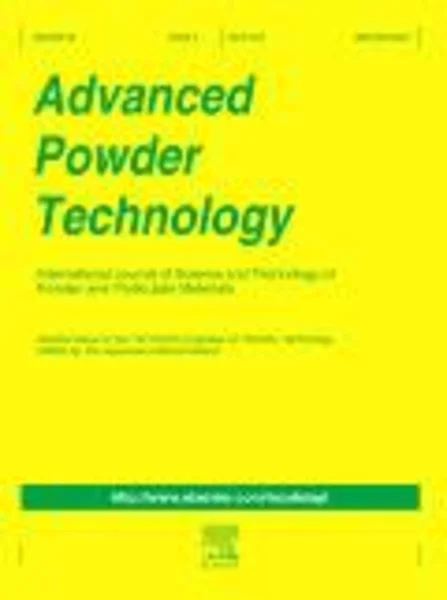-
effect of operating conditions on the hydrophobisation of silica-based porous particles in a fluidised-bed reactor: temperature effect
جزئیات بیشتر مقاله- تاریخ ارائه: 1393/01/01
- تاریخ انتشار در تی پی بین: 1393/01/01
- تعداد بازدید: 649
- تعداد پرسش و پاسخ ها: 0
- شماره تماس دبیرخانه رویداد: -
this study concerns the modification of silica surface wettability by silanisation reaction which consists in the transformation of hydrophilic silanol groups into hydrophobic groups. the chemical modification of silica surface is carried out using n-octadecyltrichlorosilane (odtcs). it is a reagent with three chlorines as functional group and with one long alkyl chain containing 18 carbon atoms, responsible for the hydrophobic behavior. the reaction is performed at dry phase and by mixing two classes of particles during the fluidisation: target particles to be treated (mp silica 63–200 active 6 å) and odtcs-carrier particles consisting of coarser porous alumina beads (300–800 μm) containing an adequate amount of reagent. the aim of this work was to study the effect of the temperature (from 30 to 110 °c) at dry condition on the silanisation reaction rate and the silica surface characteristics. the hydrophobisation treatment is characterized by ir/atr, washburn method, elementary analyses and rmn. the experimental results show that the reaction rate increases with temperature in dry environment but this effect seems to be more significant at lower temperatures. also, the quantity of reagents can be estimated by measuring the amount of hcl generated by the reaction using a ph sensor. the rmn spectra showed an increased extent of disordering of the grafted chains at lower operating temperatures.
مقالات جدیدترین رویدادها
-
استفاده از تحلیل اهمیت-عملکرد در ارائه الگوی مدیریت خلاقیت سازمانی و ارائه راهکار جهت بهبود
-
بررسی تاثیر ارزش وجوه نقد مازاد بر ساختار سرمایه شرکت های پذیرفته شده در بورس اوراق بهادار تهران
-
بررسی تأثیر سطح افشای ریسک بر قرارداد بدهی شرکت های پذیرفته شده در بورس اوراق بهادار تهران
-
بررسی تأثیر رتبه بندی اعتباری مبتنی بر مدل امتیاز بازار نوظهور بر نقد شوندگی سهام با تأکید بر خصوصی سازی شرکت ها
-
تأثیر آمیخته بازاریابی پوشاک ایرانی بر تصویر ذهنی مشتری پوشاک ایرانی (هاکوپیان)
-
مشروعیتِ آراء عمومی در نظام سیاسی مبتنی بر مردم سالاری دینی در اندیشه امام خمینی (ره) «شرحی بر جایگاه مردم در اِعمال حق انتخاب حاکم در حکومت دینی»
-
بررسی اثر کاربرد صفحه های پرسنلی، کامپوزیتی و فلزی بر مقاومت به شکست دندان های قدامی reattachment شده
-
ارائه یک سیستم توصیه گر وب معنایی مبتنی بر فیلتر کردن تجمعی
-
a new algorithm to compute secondary invariants
-
vibration analysis of rotating machinery using time–frequency analysis and wavelet techniques
مقالات جدیدترین ژورنال ها
-
مدیریت و بررسی افسردگی دانش آموزان دختر مقطع متوسطه دوم در دروان کرونا در شهرستان دزفول
-
مدیریت و بررسی خرد سیاسی در اندیشه ی فردوسی در ادب ایران
-
واکاوی و مدیریت توصیفی قلمدان(جاکلیدی)ضریح در موزه آستان قدس رضوی
-
بررسی تاثیر خلاقیت، دانش و انگیزه کارکنان بر پیشنهادات نوآورانه کارکنان ( مورد مطالعه: هتل های 3 و 4 ستاره استان کرمان)
-
بررسی تاثیر کیفیت سیستم های اطلاعاتی بر تصمیم گیری موفق در شرکتهای تولیدی استان اصفهان (مورد مطالعه: مدیران شرکتهای تولیدی استان اصفهان)
-
بررسی رابطه اختیار معامله (خرید)، بازده مورد انتظار و تعدیلات ساختار سرمایه در شرکت های پذیرفته شده در بورس اوراق بهادار تهران
-
تأثیر پذیری عرفان سهراب سپهری از عرفان سهروردی
-
بررسی رابطه تولّی و تبرّی با توحید از دیدگاه علامه طباطبایی (ره)
-
تاثیر تکنیک های خود انگیزشی برخودکارآمدی کارکنان در حال تحصیل سازمان ثبت اسناد و املاک
-
تاثیر نوآوری در کسب و کار آنلاین بر عملکرد فروش با نقش میانجی بازاریابی در فضای مجازی




سوال خود را در مورد این مقاله مطرح نمایید :